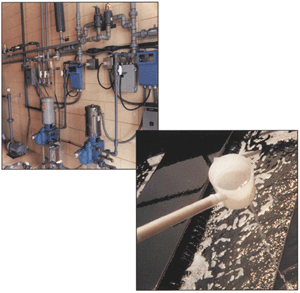Wastewater Treatment Plant Uses Diaphragm Pumps

Built in 1977 at a project cost of $6 million, the Pennridge wastewater treatment facility, located on the East Branch of the Perkiomen Creek north of Philadelphia, provides advanced treatment and disinfection of wastewater before it is discharged to the creek. It has a capacity of 4 million gallons per day and serves 25,000 people in six municipalities in Bucks County, PA.
After large pieces of debris (sticks, leaves, rags, etc.) are removed in the pretreatment step, the wastewater flows into wet wells at the raw wastewater pumping station. Raw wastewater pumps lift the influent (or) incoming wastewater to primary treatment facilities where settleable solids are separated and removed.
Next, in the Flash Mixing tank, chemicals are added to the wastewater to precipitate phosphorous. The wastewater is then gently agitated in the flocculators to promote coagulation of large, readily settleable floc.
Precipitated solids are removed as the wastewater flows through primary setting tanks. The clarified effluent flows by gravity to two trickling filters (round beds with various size rocks), where bacteria and other microorganisms attached to the rocks consumes the organic material.
The wastewater passes through aeration tanks and into secondary clarifiers where the final polishing step is carried out to produce a clear effluent for discharge into the creek.
Pumping Polymer for Clean Effluent
Ferric chloride, a coagulant which provides a positive charge, is pumped into the wastewater at both the primary clarifiers and at the end of the aeration tanks for total phosphorous removal.
Anionic polymer is fed into the effluent from Pennridge's aeration tanks for final clarification before discharge. The polymer provides a negative charge and acts as a polishing agent to remove trace suspended solids, BOD and insoluble phosphorus from the water. "It's the polymer that helps settle and coagulate the solids and bring them all together so you have a clean effluent, to meet today's stringent permit limits," said Pennridge's Manager, Pat Donovan. "This polymer is critical to the clean, clear effluent that must be discharged into the Perkiomen Creek, and it's important that we add it in just the right dose."
Two hydraulic diaphragm metering pumps are used to feed the polymer to the effluent. Several years ago, according to Donovan, Pennridge wanted to increase the polymer dosage, but the pumps being used at the time presented a problem.
"We wanted to increase the dosage," Donovan related, "but we weren't sure of the dosage rates with the old belt driven pumps, because they weren¡¦t very accurate."
The pumps being used at the time did not have flooded suction, so the pumps were being starved. The tanks and lines had to be cleaned out. Rebuilding the pumps was attempted but, according to Donovan, "they still didn't work" in terms of being able to significantly increase the dosage of polymer.
So, in 1993, Pennridge installed two new Series 560 hydraulic diaphragm metering pumps built by Neptune Chemical Pump Co., Lansdale, PA, to feed the anionic polymer into the wastewater.
The polymer, which comes into the plant in dry crystal form in sacks, is mixed with treated wastewater in 1,000-gallon tanks in a pump room located in the main control building. The Neptune Series 560 pumps the solution at a rate from 0 to 40 gallons per hour. "The flow rate is set according to the flow demands of the system at the time," explained Donovan. "This varies with the time of day, rainfall and other factors that impact the demand on the plant."
A 4-20 mA signal is fed from the effluent flow meter to the pumps. Automatic controllers are used to set the flow rate.
Reliable Pumping System
"There is not a whole lot to go wrong with these pumps compared to the ones we used before," he noted. "They have cast iron bodies, and they're much easier to adjust and calibrate. You set that knob (on the micrometer dial) to 50% (of flow capacity, or 50% of 40 gal./hr.), do your draw-down, and you know you¡¦re going to get 50% (20 gal./hr.) right on the button."
"We like the simplicity of the Neptune pumps," said Lloyd Dooley, Pennridge's Maintenance Supervisor. "We've had them here since February 1993 and we've hardly had to do a thing to them other than rebuild the check valve system; plus, they're easy to get parts for."
The Series 560 pumps are adjustable while running using Variable Oil By-pass„· stroke length adjustment that allows better valve performance than variable linkage designs. It's EZE-CLEAN valves can be removed for cleaning without disturbing the piping connections to the pump.
Technical assistance on the operation of the pumps is also readily available. "When we re-built the check valve system, and changed the hydraulic fluid, we didn't let the oil get back into the hydraulics and into the diaphragm," recalled Dooley. "So we called Neptune, and they said to put the knob back to zero and let the pump run. Sure enough, after three hours, the hydraulic fluid came right in."
Pennridge is now looking at a new pump system to replace the three pumps that are feeding the ferric chloride. "We're definitely going to call Neptune," said Pat Donovan. "Those pumps we¡¦re using to feed the polymer will last 20 years, easily, and we like that kind of reliability."
Neptune Chemical Pump Co., Inc., PO Box 247, Lansdale, PA 19446. Tel: 215-699-8700; Fax: 215-699-0370.
